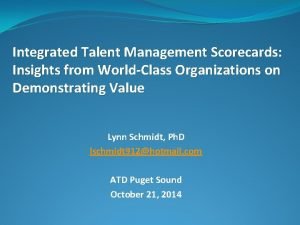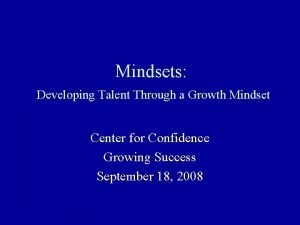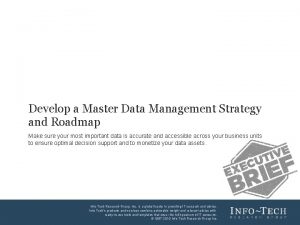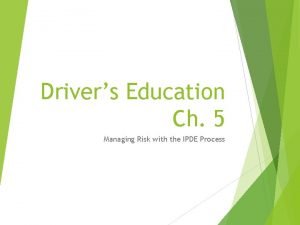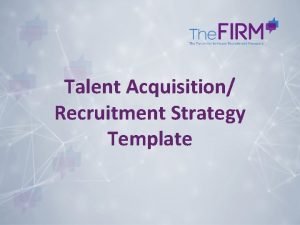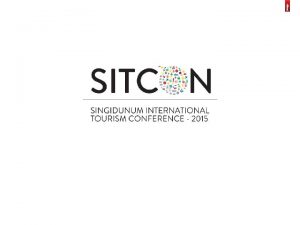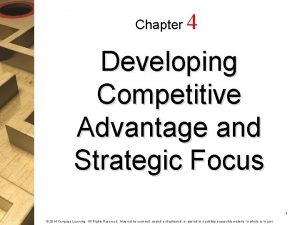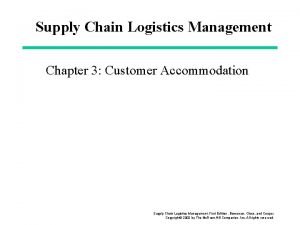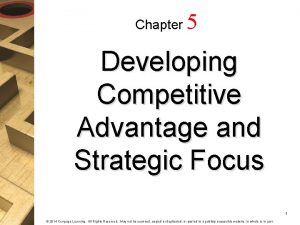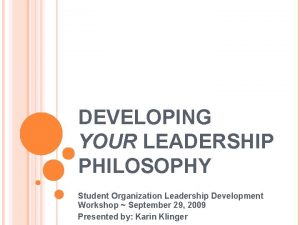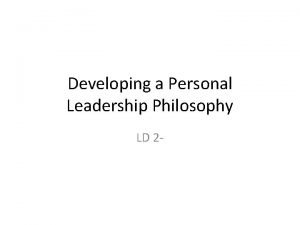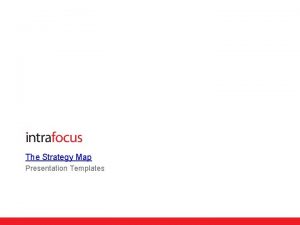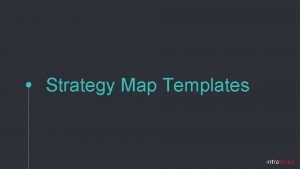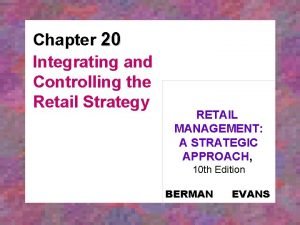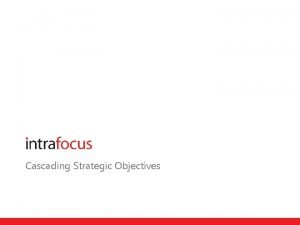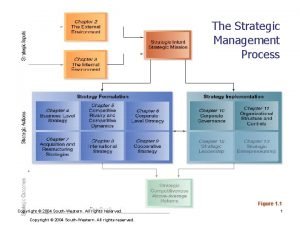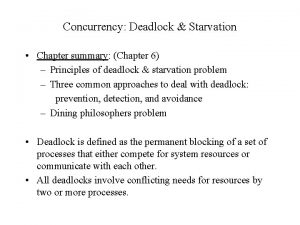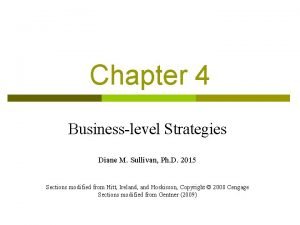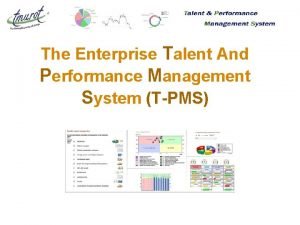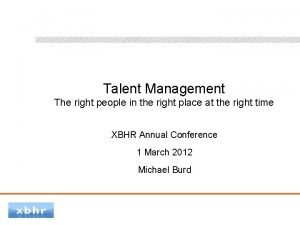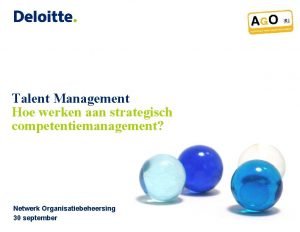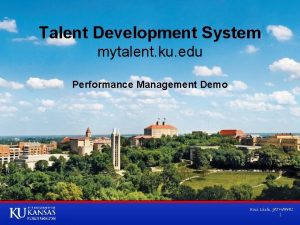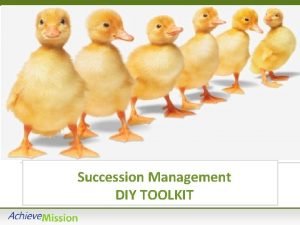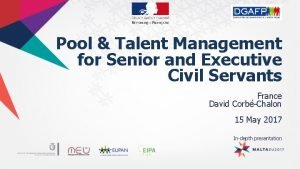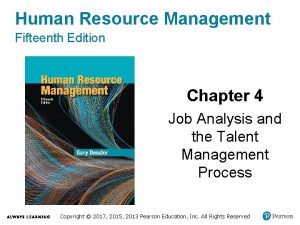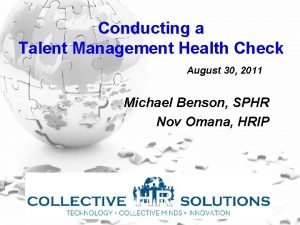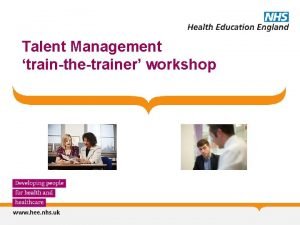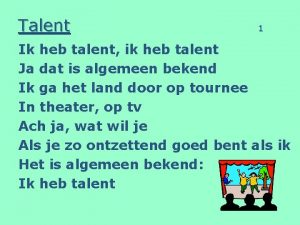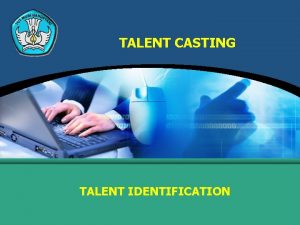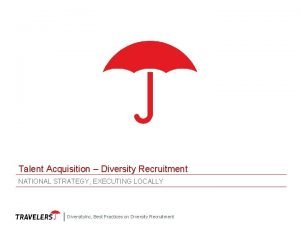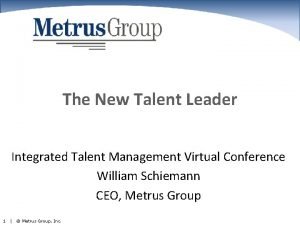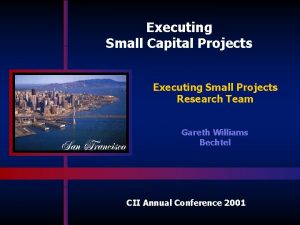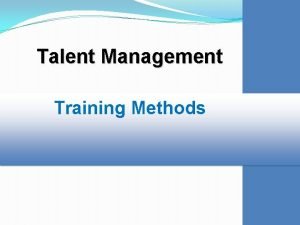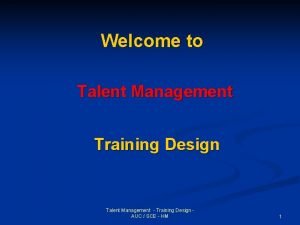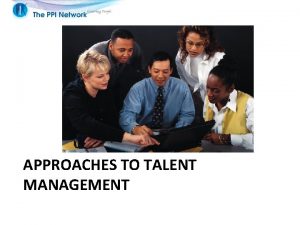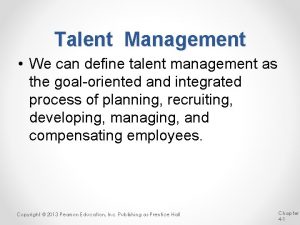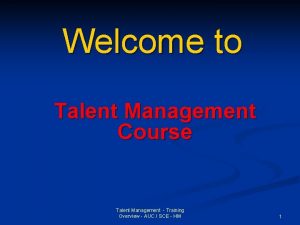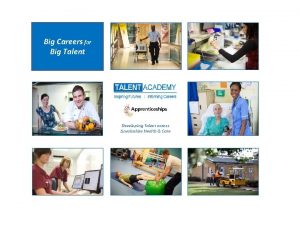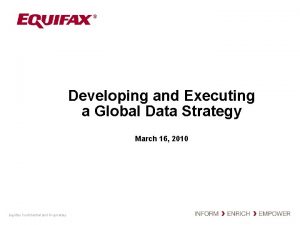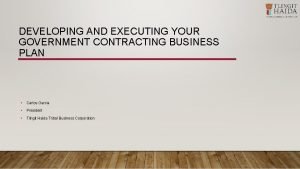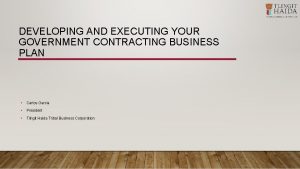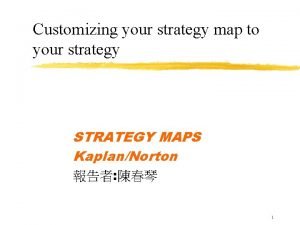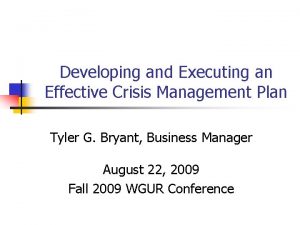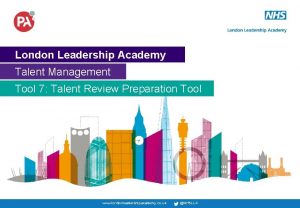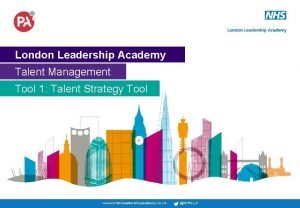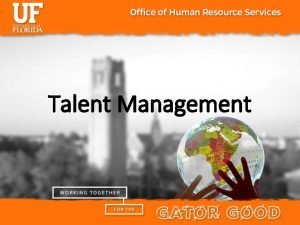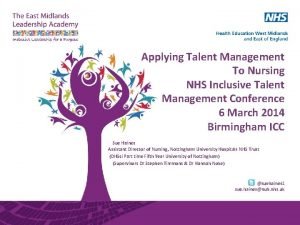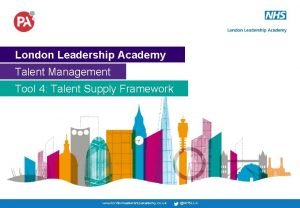Developing Executing Your Integrated Talent Management Strategy Ron
































- Slides: 32

Developing & Executing Your Integrated Talent Management Strategy Ron Hanscome, HRchitect August 23, 2012 © 2012, HRchitect, Inc. 1

Agenda § Situation summary § Integrated Talent Management (ITM) concepts & models § ITM strategy development & execution § Final thoughts © 2012, HRchitect, Inc. 2

Speaker Bio § HCM Technologist for 27+ years § Practitioner, consultant, software vendor executive, researcher / industry analyst § Current role: VP, HCM Systems Strategy, HRchitect © 2012, HRchitect, Inc. 3

A few words about… §Human Capital Management (HCM) strategy and HCM systems evaluations, implementations, integration, optimization §Team of senior-level HCM systems professionals that work as a collaborative team delivering end-to-end HCM consulting services §More than 2000 successful consulting engagements over the past 15 years for more than 900 clients §Founded in April 1997, Headquartered in Frisco, TX © 2012, HRchitect, Inc. 4

Situation summary § 2011 ended with an uneven recovery and some trepidation continuing deep into 2012 § Business response: o From cost cutting (‘ 09) to cautious investment (‘ 10) to more widespread growth & hiring (1 H/11) o Some jobs coming back to US? o Modest growth predicted for 2012…pending resolution of EU debt crisis, US election results, etc. How will all this impact your organization and its people? 5

Situation Summary • In particular, what about these basic employee types? o o “Happy to have a job” “Quit & Stay” “Scarred Survivor” “Biding My Time” § US overall job satisfaction has retreated from a high of 86% in 2009 (Source: SHRM 2011 Research Report) § 49% of US workers say “My job is unrewarding and saps my energy” (Source: Right Management Survey, 2011/12) © 2012, HRchitect, Inc. 6 6

Good questions for HR • How do we re-engage our employees? • What talent do we need as business improves? How is that different from now? • What are the current and future talent gaps? • Which positions should we grow from within? • Is our talent properly deployed now? • How do we keep the best / brightest growing with us? • Are we prepared for planned and unplanned leadership needs/changes? The ability to find, measure and develop talent has never been more important – but how? © 2012, HRchitect, Inc. 7

One good answer… Integrated Talent Management (ITM) • Definition: A comprehensive approach to maximizing the performance of the workforce by deploying integrated processes and enabling technologies • Goal: break down the process and information barriers between HR functional silos • Done right, ITM should permeate the entire employment / talent lifecycle 8

…improperly executed… • Many “ 1 st generation” talent management initiatives have not met expectations o o Cost/benefit User adoption Improving HR effectiveness Impacting business results © 2012, HRchitect, Inc. 9

…improperly executed… • Contributing Factors: o o Immature technology Project management issues Mismanaged roll-out, change management Lack of an aligned, integrated talent management strategy How do we learn from past mistakes and take 2 nd generation ITM implementations to the next level? © 2012, HRchitect, Inc. 10

Employment/Talent Lifecycle Source: HRchitect © 2012, HRchitect, Inc. 11

A Conceptual Model for ITM © 2012, HRchitect, Inc. 12

Developing & Executing ITM © 2012, HRchitect, Inc. 13

Philosophy “What is our overall approach to managing talent? ” • What are your firm’s people management operating principles? o What are the variables (worker level, type, etc. )? • What changes would make an ITM approach feasible? o Breaking down function HR silos o Embracing and managing change • Is your firm willing to sign up for the changes? o Initial and ongoing executive sponsorship © 2012, HRchitect, Inc. 14

Strategy “What are the high level focus areas and outcomes? ” desired • Business linkage • Variations by geography and location o o Workforce composition (demographics, types) Culture Adaptability Use of social networking / collaboration tools • Determine key job families o ITM investment is not spread like peanut butter! • Characteristics of top performers © 2012, HRchitect, Inc. 15

Science “What tools & methodologies will enable us to best measure & predict outcomes? ” • Applying the principles of individual & organizational psychology to HR o o o Skills, behaviors, competencies Performance Leadership Engagement Fit to culture • Forms the basis of assessment (pre and post-hire) & engagement analysis • Enables linkage to business outcomes • Includes development of a measurement framework © 2012, HRchitect, Inc. 16

HCM metric taxonomy Predictive Modeling Impactful Effective Correlated Analytics Contextual Embedded Analytics Metrics Delivery (Dashboards) Efficient Information Distribution Complexity © 2012, HRchitect, Inc. 17

Metrics that Matter (learning) Impact of learning on business results Trainee progress vs. dev plans Impactful Effective % of ees w/ dev plans Cost per training hour Efficient % employees trained Number of training days/programs per yr Learning forecasting Learning Effectiveness Analysis Efficiency of training enrollment Performance of trained vs. untrained Impact of learning on dept schedules/budget Complexity © 2012, HRchitect, Inc. 18

Metrics that Matter (performance) Impact of perf mgmt on business results Perf Mgmt / Learning linkage Impactful Effective % of ees unreviewed for > 2 yrs. Effectiveness of perf Pay for Performance mgmt Alignment Perf. ratings distribution Efficient % employees reviewed Efficiency of perf mgmt process Perceived credibility of perf mgmt Number of reviews completed on-time COMPLEXITY © 2012, HRchitect, Inc. 19

Developing the measurement framework • Don’t “boil the ocean” and attempt to measure everything all at once • Dialogue with stakeholders to determine the most critical metrics • Develop an initial metrics subset • Build a timeline for extending the metrics framework with additional subsets • Remember to use results from the initial subset to drive the extensions © 2012, HRchitect, Inc. 20

Process “Which practices maximize process efficiency, effectiveness and business value? ” efficiency effectiveness business value • Some level of redesign must occur in order to leverage new technologies o Otherwise, why bother? • Identify critical leverage points between ITM functions (shared data, outcomes, metrics) o Examples – recruiting, performance management, learning • Build in metrics from the ground up © 2012, HRchitect, Inc. 21

Process • Key outcome for this phase – high-level process redesign to drive technology selection o Again, apply the 80/20 rule! • Detailed redesign at this point is premature o Detailed “to be” process designs are dependent on the specific enabling technologies selected o Whatever is implemented will have gaps that will require process adjustments o Going detailed at this point will waste time and resources • Wait to do detailed process redesign until the fit/gap analysis phase of implementation © 2012, HRchitect, Inc. 22

Technology (finally) “What tech solution(s) best enable our ITM processes? ” • Tech strategy linked to HR strategy linked to business strategy – not vice versa • Focus on your real requirements, not bells & whistles (most end up never being used) • Pursue scenario-based evals vs. checklist-style RFPs • Assess other decision drivers than functionality & cost Vendor Viability Package User Experience Service / Support Technology & Scalability Global Capability Integration / Interoperability Configurability Remember the due diligence process! © 2012, HRchitect, Inc. 23

The Technology Bottom Line • No vendor yet delivers functionality equally well across all ITM functions o Some are getting close • Many vendors are working hard to: o Expand their functional footprint o Incorporate social, mobile & collaboration o Move into other geographies © 2012, HRchitect, Inc. 24

The Technology Bottom Line • Consolidation will continue • Growth by acquisition = a potential mess “under the hood” • The wonders of “SOA” and “Plug & Play” integration are often oversold – caveat emptor! © 2012, HRchitect, Inc. 25

Implementation “How do we deploy the new technology-enabled processes to achieve desired strategic outcomes? ” Now, the real work begins… • Detailed implementation planning • Preliminary product training • Detailed fit/gap analysis • Detailed process redesign • Deployment of testing instances / zones for conference room pilot • Integration to 3 rd party and enterprise apps • Solution configuration (processes, workflows, metrics) 26

Implementation “How do we deploy the new technology-enabled processes to achieve desired strategic outcomes? ” Now, the real work begins… • Development of initial reporting, dashboards and analytics • Conversion of current and historical data (how much history? ) • System testing – component, process system, UAT • User training & change management • Ongoing communication and internal marketing • Transition to live production and stabilization © 2012, HRchitect, Inc. 27

Implementation • Pursue a “chunking” strategy with a 3 -5 year roadmap that starts with biggest pain points • Project teams almost always underestimate integration / interoperability issues o Third party providers o Niche applications o Applications within the enterprise • Firms chronically under-invest in: o Internal marketing/communication o Rollout o Change management project • Utilize dedicated resources if possible • Get senior management support over project life © 2012, HRchitect, Inc. 28

Sustainability “How do we maintain and evolve the solution to adapt to changing business and HR needs? ” • Even though the solution is “live, ” your business is not standing still • Plan and budget for the evolution of the solution on a regular basis • Continue a regular program to market the solution • Regularly update senior management on progress • Build stakeholder feedback into the apps roadmap • Remember the governance model! © 2012, HRchitect, Inc. 29

Final Thoughts • The current business environment combined with worker intentions will likely stress existing talent management processes • Many first generation talent management implementations have fallen short due to a lack of a cohesive, aligned strategy © 2012, HRchitect, Inc. 30

Final Thoughts • Take the time to build an ITM initiative according to the seven step methodology, focusing on philosophy, strategy and science first – with metrics!! • Technology is a critical enabler…with the right focus on functional integration points and user experience © 2012, HRchitect, Inc. 31

Q&A/ Comments Ron Hanscome VP HCM Systems Strategy HRchitect Office: 763 -383 -2933 E-mail: rhanscome@hrchitect. com Blog: www. puzzlingworldofhrtechnology. com Twitter: @ronhanscome © 2012, HRchitect, Inc. 32
 The strategy making strategy executing process
The strategy making strategy executing process Talent management scorecard
Talent management scorecard Plating arrangement
Plating arrangement Mindsets: developing talent through a growth mindset
Mindsets: developing talent through a growth mindset Data management roadmap
Data management roadmap What is the zone control system in driving
What is the zone control system in driving Diversity recruitment plan template
Diversity recruitment plan template Talent strategy in travel industry
Talent strategy in travel industry Developing competitive advantage and strategic focus
Developing competitive advantage and strategic focus Customer accommodation meaning
Customer accommodation meaning Developing a firms strategy canvas focuses on
Developing a firms strategy canvas focuses on Developing your leadership philosophy classes
Developing your leadership philosophy classes Achieving mental and emotional health
Achieving mental and emotional health Developing your leadership philosophy classes
Developing your leadership philosophy classes Strategy map ppt
Strategy map ppt Kaplan and norton strategy map
Kaplan and norton strategy map Integrated retail strategy
Integrated retail strategy Cascading strategy map
Cascading strategy map Multidivisional structure advantages and disadvantages
Multidivisional structure advantages and disadvantages All deadlocks involve conflicting needs for
All deadlocks involve conflicting needs for Integrated cost leadership/differentiation strategy
Integrated cost leadership/differentiation strategy Porters strategies
Porters strategies Give us your hungry your tired your poor
Give us your hungry your tired your poor Enterprise talent management software
Enterprise talent management software Cipd
Cipd Integraal talent management
Integraal talent management My talent ku
My talent ku Talent management toolkit
Talent management toolkit Sap erp hcm performance management
Sap erp hcm performance management The pool talent management
The pool talent management Chapter 4 job analysis and the talent management process
Chapter 4 job analysis and the talent management process Health talent management
Health talent management What do we mean by being talented
What do we mean by being talented

